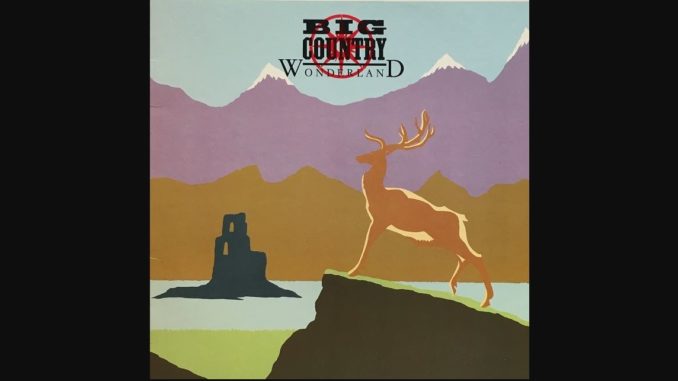
Big Country emerged on the world stage with their debut album The Crossing on 29 July 1983. The UK success was immediate, slowly but surely spreading to other territories around the world as well. The album was a great chart performer in its own right, but also spawned several hit singles, allowing the following tour to keep going for nearly a year.
Hardly a corner of the UK was left alone, with memorable appearances all over the place – including the Reading festival where Big Country set an unplanned record for pyro and explosions usage. The band then veered into mainland Europe, toured across America, and starting on the far east territories with Japan before the summer of 1984. At that point it had been a gruelling haul, and with exhaustion starting to set in the tour was cut short just before the band’s planned visit to Australia.
There had obviously been some breaks here and there. After a New Year’s homecoming show, the band had January and most of February 1984 off. Or, at least they were not on tour. There were still activities going on.
The record company had requested that the band record a new song to be released as a single during their break in touring to keep Big Country in the public eye. The band obliged, and the new track was released on 13 January 1984. That track was Wonderland – one of the band’s best and most beloved tracks.
If you could feel how I must feel
The winds of quiet change
If you could see what I must see
Still hidden in the rain
But when the thunder rolls
It comes and covers up my soulAnd you will take my hand
And be with me in wonderlandI am an honest man
I need the love of you
I am a working man
I feel the winter too
When guitarist Bruce Watson was asked by The Great Divide – the Big Country podcast if he could recall any band-related Christmas memories, his thoughts actually went to this song: “I would say Wonderland, because it was recorded right around Christmastime. We should get Mark to overdub some sleighbells on it to make it sound Christmassy!”
There certainly was a lot of activity related to that song’s impending release during Christmas 1983, not the least preparing for the song’s live debut on New Year’s eve of that year. These memories must override Watson’s memories of the recording of the song, which actually happened a few months earlier, around the last week of October 1983.
The band wrapped up the European leg of the Crossing tour on 19 October and planned to begin their North American tour on 8 November. While this pause in touring looks like a nice chance for a break, that wasn’t on the cards. After a few days at home, the band had to reconvene to finish writing and recording the requested new song. With that done, they dove straight into preparations for their coming American adventure.
In vocalist/guitarist Stuart Adamson’s introduction to the song at Barrowlands on 31 December 1983, he said “Before we went to America we went up to Scotland, recording in a place just outside Edinburgh, and this is what came out of it. It’s a song called Wonderland. It’s our new single and it’s out in a couple of weeks.”
Adamson also spoke about the song’s creation in an interview with Melody Maker in 1990: “I really like Wonderland. The side of Big Country that’s about innocence and a sense of wonder and a belief in how people can get it on with each other, it’s all there in Wonderland. The song just came out of a jam. It’s a bit dense as a single but as a song it works great.”
The song would indeed get its final form when the band started to jam it, but the initial spark came from an instrumental demo by Bruce Watson.
Watson’s demo contains the main riff which would be prominently used in the finished song’s intro and frequently throughout. As the band adopted that riff and started using it in a fuller song, it quickly grew beyond that starting point.
The demo was included on Watson’s website CD release Last of the Hole In the Head Gang in 2001. He also included it on the expanded reissue of his Demology collection in 2005. It has the title Wonderland on these releases, although this is an after-the-fact naming. The lyrics/title had not yet been written as the demo was made, so the piece either had no initial title, is forgotten, or was left aside for a naming most people would relate to.
In 2001, Watson also shared a clip of an instrumental in-progress version of Wonderland on his website. This version was quickly named Wondergreat by fans as it included elements of both Wonderland and the Steeltown track The Great Divide. The full-length version of that clip, along with an earlier ‘work in progress’ version, was eventually released on the 2014 2CD deluxe edition of Steeltown.
As the goal of the sessions was to provide a single, some streamlining and simplifying was in order. Wondergreat had too many ideas in it, and with the capable help of producer Steve Lillywhite, the track was split into sections with some basic elements kept. The rest was left aside for when they got to work on the Steeltown album in Stockholm by late summer 1984. But that is another story…
The song had been recorded just ahead of the US tour which would go on for most of the rest of 1983. As the plan was to release it very early in 1984, the video for the song had to be shot while they were in America. They decided on an area with enough rolling hills to remind viewers of the band’s own Scottish highlands, shooting in the Mt Hood area outside Portland, Oregon on 10 November 1983.
In an interview about the video on MTV on 6 March 1984, Stuart refers to the video location as “where they shot the exteriors for The Shining” which narrows the location down to the area around Timberline Lodge.
This was easily one of the band’s busier days on the tour. The video location would have been about 1,5 hours of travel time each way from downtown Portland, plus however long it took to shoot the video.
In a Facebook comment, Bruce Watson mentioned that the video shoot location was so cold there that the guitars were unable to be tuned – and Stuart is seen wearing not much more than a thin sweater!
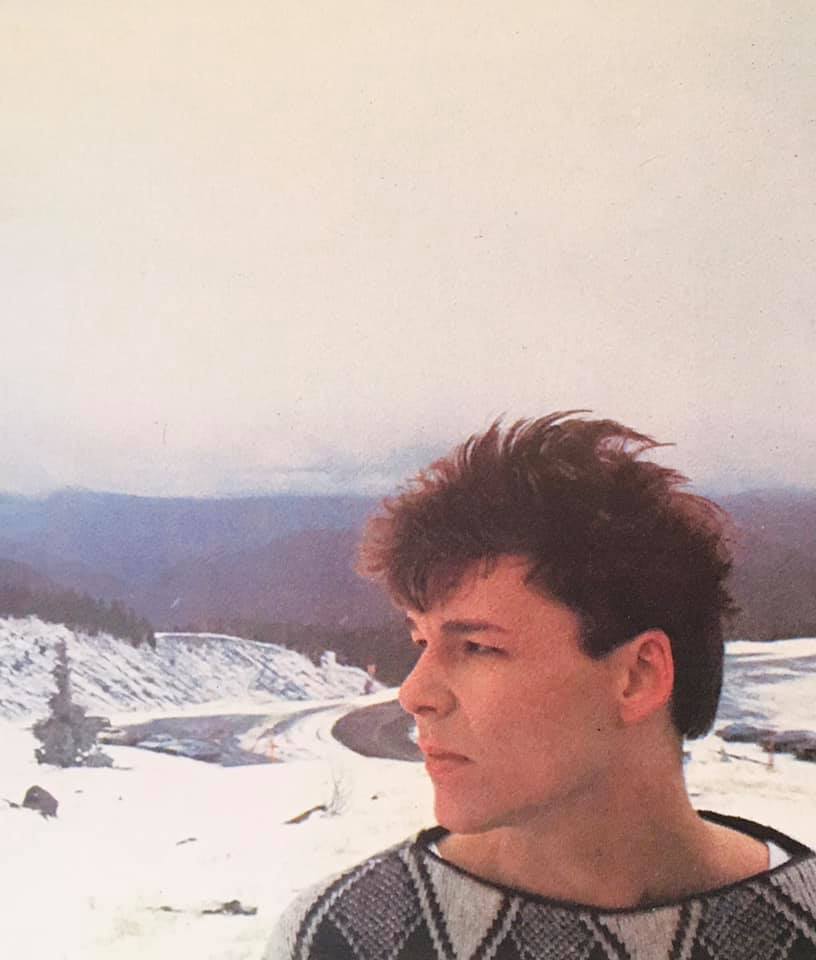
After returning from the video shoot, they did a record store appearance and went straight into preparing for the gig at the Starry Night nightclub! Thankfully, the next day was a day off, albeit by necessity – it was spent on the long drive ahead of them to their next gig in San Francisco.
Musically, Wonderland is explosive in its power. The intro alone is worth a study. The recurring guitar pattern played over quiet percussion is the quiet before the storm. A huge drum roll heralds the arrival of the full band as the guitars crash in alongside one of the best bass lines in rock music. Stuart lets loose an emotional “mountain cry” – the first of many in the song – and we’re off.
And all of this takes place in mere seconds.
The intro is simply speaking glorious. The following verse is bouncy and upbeat musically, and although the lyrics have their moments of doubt and insecurity in them, there are also intense expressions of love and devotion. There’s even hope and measured optimism. This is never a given in Big Country’s song catalogue, which is known for its many examples of upbeat music set to downbeat lyrics.
The same explosiveness that we hear in the intro can be heard every time the song enters a chorus, which always emerges like a sunburst firing across the sky. The pre-chorus sets it up beautifully.
And you will take my hand
And be with me in wonderland
The song explodes as the title word is sung out loudly, becoming a mountain cry of its own alongside the crescendo of drums and the guitars. The emotional impact is immense. As a listener, the song gives you wings. You are lifted and carried away.
The song eventually arrives at a lovely middle section (“With innocence, within ourselves”), which would be extended in live settings over the years. Typically, Watson would play the bottom-end guitar part over and over alongside the drums while something happened elsewhere on stage. Back in the day Stuart Adamson would often interact with the audience personally, say something to everybody, play other riffs or solos on top… whatever he felt compelled to do on any given night. It would became a moment of loosely planned spontaneity which always signalled a bit of fun at Big Country shows.
Bassist Tony Butler is always called out for his contributions to the song, with extremely good reason. Is Wonderland his best ever bass line? A lot of Big Country fans seem to think so, with Butler’s band mates Watson and Brzezicki (as well as Big Country bass alumni Derek Forbes and Scott Whitley) also having pointed to this bass line as his best. Butler seems to feel similarly, frequently mentioning this as one of his favourite bass lines to play.
Tony Butler did a series of bass play-through performance videos for Chowny bass guitars back in 2019, and the bass line by itself (well, with drum accompaniment) is a thing of beauty.
As the song was relatively quickly written and recorded, this would by necessity dictate that the lyrics also had to be written within a short period. This does not, however, mean that they were hastily thrown together. It might instead have contributed to a stylistic change.
The lyrics of the first few years, leading up to The Crossing album, were often more mystical and allegorical. They would return to that style of lyrics on the next few albums, and while Wonderland still have some interesting lyrical nuggets to chew on, the track is decidedly more direct than previous ones. Never a bad thing for a song slated to be a single.
At its core, the words in the song are those of a man talking to the woman he loves. He is sharing a number of things with her – concerns, worries, laying out how he feels, being honest. The overriding thing is that although he acknowledges that he has his issues, as long as she is with him, a lot of those issues matters less. The song basically says, ‘this is how I am without you, and this is how much better I can be with you.’
If we look closer at the verses, a new thing is revealed in each of them. The first verse it all about having fears.
The man sees that change is coming (“If you could feel how I must feel / The winds of quiet change”). It’s interesting how he refers to it as ‘quiet change’ – in other words, the change not obvious, and might even hidden (“Still hidden in the rain”). But the man in the song sees it, and it concerns him, but does not overwhelm him until it all gets too much and becomes a proverbial thunderstorm (“But when the thunder rolls / It comes and covers up my soul”).
In other words, he is talking about is his worries, his anxieties, his depression. It’s all there, but it’s not a constant. Sometimes it overwhelms, but not all the time, and there is something that helps (“And you will take my hand / And be with me in wonderland”).
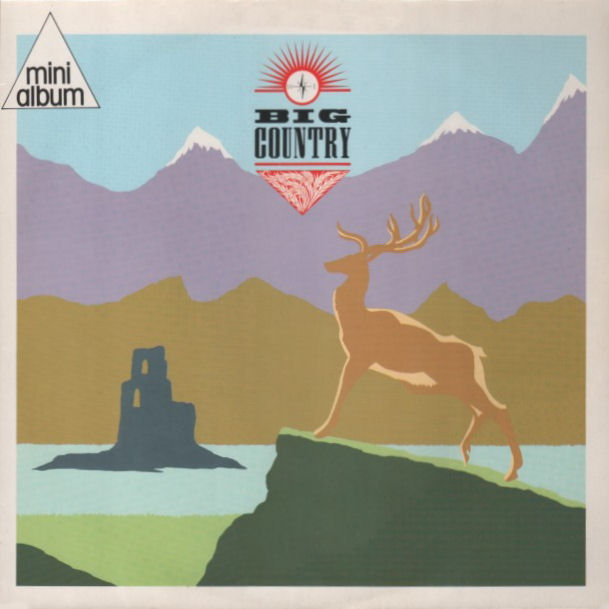
The chorus always goes back to this, making them the focal point – the redemption, the help that makes everything better. Together, they have a wonderland. Together, they are the wonderland. As the song goes on, we will see that it does not always make everything completely fine, but it does make it better.
In this chorus, Adamson is using winter as an allegory for depression. He “feels the winter too” – he is not spared the moments of dark thoughts. This was an allegory he used in a number of songs over the years, which sadly mirrored Adamson’s own periodical struggles with depression. He put a lot of himself in songs like this, which made them feel that much more genuine.
If the first verse was about having fears, the second one is about hardships. Having a hard life, doing demanding work (“Nothing would replace / The fifty years of sweat and tears / That never left a trace”). If the narrator lived through ‘fifty years of sweat and tears’ we’re certainly not talking about a young man, but he could also be talking about a people; a local community. Something was built here that has lasted all that time, but how could fifty years of sweat and tears not leave a trace? There is a positive and a negative way of looking at that.
Best case, it could mean that it was worth it. There may have been sweat and tears, but they didn’t leave a trace – the people weathered it. This very much reminds us of a classic Big Country lyrical theme about pride that grows through hardship and honest work.
A more negative way of looking at that section is that the work meant nothing. It had no impact, their efforts left no trace. That sounds dramatic. Could this section really hint at a larger level of doom and gloom?
Well… it might. This is Big Country, after all. If the first verse is about having fears, and the second one describes a hard-working life, the third is looking back at events that now lie in the past – seemingly dramatic events for the local community.
Initially, the third verse refers to a sense of pride in the work that was done and in the accomplishments of the local community (“You still remember other days / When every head was high”), but it was not meant to last: (“I watched that pride be torn apart / Beneath a darker sky”).
In this section, Adamson is foreshadowing topics that he would delve further into on the next album Steeltown. On that album, we hear about steel mills and factory communities where there was hard manual work available for those willing to move there. People established themselves in new communities and made a living there, only to see these factories closed down a few years later. This left thousands of families without income and no immediate path onward – hence ‘beneath a darker sky’, i.e. a less hopeful sky, which could also be darkened by the factory smoke.
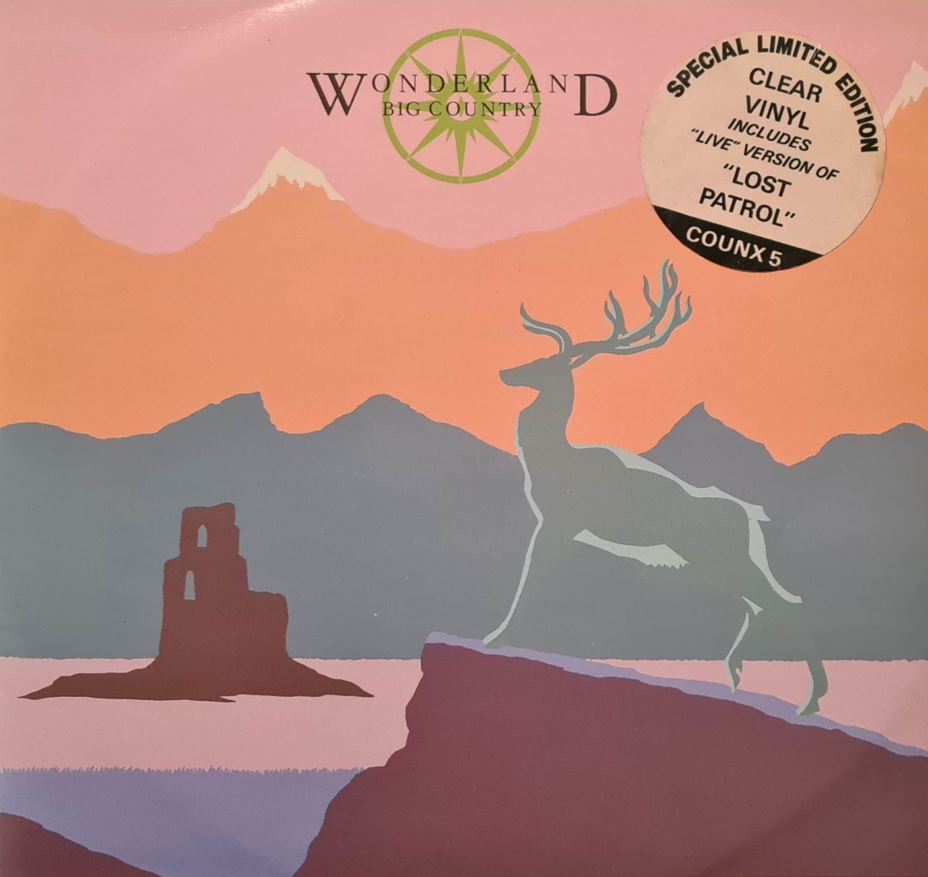
Still, although the work could be soul-crushing, you can carry an innocence within you (“With innocence within ourselves / We sing the same old song”). This tells us that in spite of everything, the man’s spirit is not broken. He is an honest working man, who shouldn’t – and doesn’t – feel ashamed about the situation he is in.
It certainly is a depressing situation, but he has his significant other, and she understands and appreciates his work and his sacrifice, as he does hers. And with that, they both have their own ‘wonderland’ despite a difficult situation.
This is why I take it as a good sign that musically, the chorus and several instrumental sections are so explosive and almost triumphant. They tell us that the guy is managing quite well in spite of the situation he is in.
In the final pre-chorus section, there is an interesting lyrical change from “be with me in wonderland” to “make believe it’s wonderland”. This is where we need to consider the possibility that Wonderland could be an ironic title. We’re working hard. I have doubts and fears. I feel the winter too. Sweat and tears that leave no trace. Pride that is torn apart beneath a dark sky. Community falling apart. Clearly things are bliss. This truly is a Wonderland, right? Let’s make believe.
That one tiny change opens up interesting possibilities as far as how to read the song. If you wanted to, you could put together a compelling argument for how the song is ironic, infused with dark humour, or just plain dark, and how it’s really a testament to desperation. Do I read the song that way? Absolutely not. There can be certainly be elements of make believe (or ignoring some of the harsher realities) in situations like the man and woman in the song are facing, and I think that is what is going on here. This is a far cry from taking everything in your situation like that. But, certainly both interpretations are possible.
The song’s lyrical themes are at home in the Big Country catalogue, and even for being somewhat more direct, as we have just seen there is still plenty to dig into. Musically, the song is huge, containing so much momentum, explosive power, and solid musicianship that it is bursting at the seams. It is a firm fan favourite.
It is interesting to note that at first, the band were far less sure that the song was as good as it could have been. In early interviews, they indicated that they didn’t have enough time to develop it. They felt it was rushed.
They were certainly under some pressure to finish it, which is never a good feeling. The US tour was scheduled to start just a week after the song was completed. But still… it’s Wonderland! Were they really not happy with the results?
When interviewed by the Australian music magazine Dolly in May 1984, Tony Butler said “Wonderland, our next single, was the last thing we recorded and that was somewhat rushed – it didn’t have time to develop before it was recorded. We know we don’t ever want to do that again.”
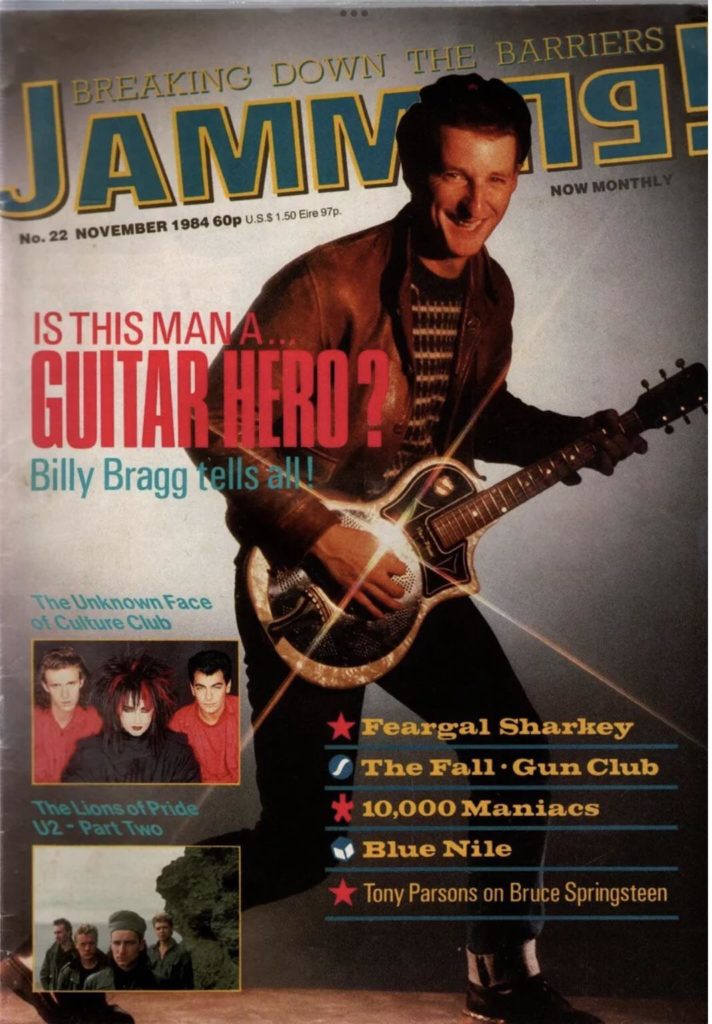
Bruce Watson adds more on this in Jamming magazine, November 1984: “We get on great with Phonogram, they don’t pressure us into writing songs, but they said ‘A single needs to come out in the new year’, so we went into the studio to try and write something. So it was the first time we’d been in that environment, where we had to sit down and try to work something out. That way of working doesn’t suit us at all, because we’re quite prepared to rehearse the stuff we’ve done, and take it out live. But now it’s getting to the stage where if we go out and play it live, it might not do as well as the old songs. I suppose it happens to every group, but we don’t like to work that way.”
The interviewer asked a follow-up question, wondering how they responded to the pressure of being thrown into the studio to write a single. Watson simply responded, “Well, we’re not going to do that again.”
True to their word, the band never did allow themselves to be in that type of situation again. They might have been encouraged to record something extra here or there, but if they didn’t want to go along with it for whatever reason, or felt something wasn’t finished, they wouldn’t be forced. When they went along with something, such as recording a new song for a best-of album, or other singles, they always made sure they had enough time to be happy with the results.
The first time Big Country performed Wonderland for an audience was at the Barrowland homecoming show on the 31st of December 1983. We’ve all seen the video/DVD from that night, which has also been released as a standalone LP and CD several times.
What is easy to forget is that the song was brand new at that time. It had not even been released. The release happened nearly two weeks later, on the 13th of January. In other words, the enthusiastic cheers you hear on that live recording are genuine first listen reactions from people hearing the track for the very first time.
Another aspect of this show was that this was a homecoming show for Glasgow. They had toured the world with The Crossing in 1983 and really proven themselves to be a band with an international appeal, they had seen incredible success since the last time they had played there ten months prior, when they had struggled to fill the Strathclyde University.
This time however, they had sold out two shows at Barrowlands – a matinee show and an evening show. Let us set the stage for that day.
On the morning of the shows, there was a torrential downpour. The wind and rain was doing its best to make life miserable for the fans waiting outside the venue, but if failed to dampen their spirits. In fact, they were having a great time, singing songs and looking forward to the return of the conquering heroes. Their mood was elevated further when despite the harsh weather they successfully managed to drape a huge banner across the front of the venue. It was a heartfelt homage to the band and their next single, bearing the text Barrowland is Wonderland.
The fans were not the only ones braving the storm. Sound and lighting engineers, as well as those from the outside broadcasting unit who was preparing to capture the event for a future video release, were busily feeding cables, cameras, and equipment into the venue.
The band turned up for soundcheck by noon, at which time there were already hundreds of fans waiting outside.
The band played two shows on that day. In addition to the evening show that was recorded, which we all know and love, they played a matinee show earlier in the day which was not recorded. That was the very first time Wonderland was played. If someone at the evening show had also seen the matinee show, they heard the track for the second time.
A few weeks later, the single was released and did well in the UK, peaking at #8. That was the band’s highest chart entry on their home turf to date, albeit not by much – the previous record was held by Chance at #9.
Before resuming the US tour at the end of February 1984, Big Country appeared on the UK music show The Tube to promote it, on 17 February 1984. This was their second of three appearances on that programme, and one of the very few times they were on a TV show in early 1984 where they could promote their current hit single Wonderland. The band turned in a fantastic performance.
A short time afterwards, the band jetted off to the US for their live performance on The Grammys, where they were nominated for “Best new artist” but didn’t win. Afterwards they immediately went into the second leg of their US Tour.
When the band resumed touring, Wonderland was part of the set, and it has been among their most frequently performed songs since then.
As the band toured America, the single was released not just in many more territories, but across multiple formats. Keeping track of them all was difficult for a while. Most of the world got the 2-track 7’’ and the 3-track 12’’ single. America got a 4-track EP, while Japan and Netherlands got a version with 5 tracks. Canada got the motherload when it came to getting the most bolstered Wonderland release – an entire mini-album of 6 tracks, with a playing time of nearly 32 minutes. A lot of the different versions were available on imports – this writer picking up the 6-track version in Norway a few years after the initial release.
Admittedly, it all might have ended up being a little confusing. Stuart Adamson mentioned this situation in a Melody Maker interview from 1990: “Because the American record company was so desperate for new material – specifically, the second album – they got together a lot of unreleased material and b-sides and Wonderland and released it on a 10-inch EP. A lot of people thought it was our second album.”
Reviewers were never kind to Big Country, and Wonderland was no exception. It mostly got moderate-to-harsh reviews. When Bruce Watson was interviewed in Jamming magazine in November 1984, the interviewer says, “You were talking about broadening out the sound a bit, but I was a bit disappointed in Wonderland. I thought it could have fitted in easily on The Crossing.” Bruce answers, “D’ya reckon? We thought it was completely different from anything on the album! I thought it was a change; it was the first wee thing we’d written for ages.”
It is interesting to note that the introductory arrangement of the song changed a bit over the years, due to a very specific stage incident in 1991. Let’s look closer.
The recorded version starts with the following progression:
- Four bars with quiet percussion while a single guitar plays the recurring rhythm pattern
- Four bars with more solid drumming and addition of louder electric rhythm guitar
- Four bars starting with a drum roll and the bass comes in, also featuring Stuart’s mountain cry
- First verse starts
The band would add a few opening bars extra with initial ‘chicken picking guitar’ to the intro in March of 1984, but that just adds something in front of the first section described above without affecting the overall structure of the intro. These sections were performed like this throughout the 1980s – all the way up to the first ever Big Country fan convention at the Glen Pavilion in Dunfermline, on the 31st of August 1991.
That’s when something happened.
Big Country are performing a set at the convention, with Wonderland somewhere in the middle of the setlist. The band starts playing the song as normal. As they get through the intro, right before Adamson is supposed to start singing the first verse, a technical issue arises with his set-up. He signals to the band to keep playing while he tries to sort things out. The others end up playing the first verse musical section a couple of times, which is enough for things to get back on track. Stuart walks up to the microphone and picks up at the appropriate moment. The song continues as normal.
This was the first time the song was performed with an extended opening section – all because of a technical glitch. The interesting thing is that this technical glitch would inform how they played Wonderland from there on.
The next time the band played live was in Bonn, Germany six days later, on 6 September 1991. Fortunately it was a Rockpalast concert, so it was captured for posterity.
This recording reveals that the band now has adapted the very same extended intro for Wonderland that they played at the convention. This time, however, it is rehearsed, with the band playing it confidently rather than tentatively. Stuart is actively using that section to fire up the audience. The convention experience must have given them something to think about. The new approach works really well in a live setting, and signals a permanent change in how the song would start for the remainder of Stuart’s days in the band.
Interestingly, after the return of the band in more recent years, they have reverted to the original way of playing the song.
Wonderland was originally a standalone single and non-album track, but it hasn’t been hard to find the song as it has been included on just about every best-of collection of Big Country music that has been released. In recent years the track has been included as a bonus track on every expanded version of Steeltown.
What we have never seen, though, is a re-release of Wonderland as a standalone release with the original cover art, which I am confident a lot of Big Country fans would be highly interested in. It is still widely regarded as one of Big Country’s best and most iconic sleeve designs. Not bad for a single which hasn’t been in print since the mid-1980s.
The cover of Wonderland was designed by Julian Balme, who did most of the band’s album and singles covers from 1982 to 1986.
In a discussion with The Great Divide – the Big Country podcast, Balme said “The whole Wonderland thing was based very much on 1930s railway posters. That was a big thing, you know, ‘Come to Scotland,’ and so on. They were really nice. There was an artist called Brian Cook who did these amazing paintings for railway companies in the 30s and 40s, and that was very much the starting point for Wonderland.”
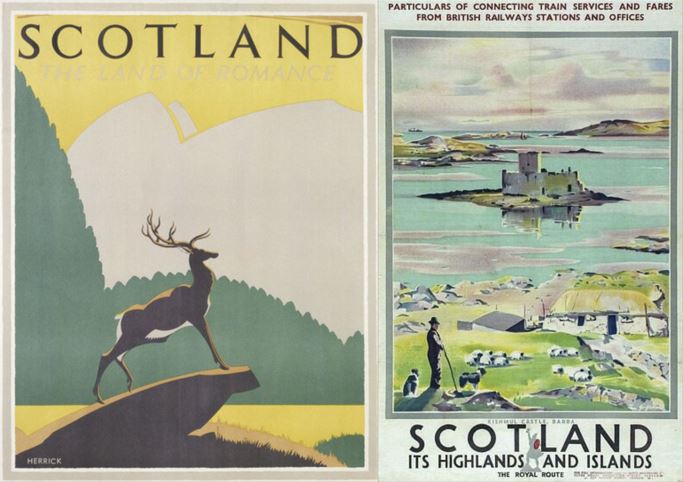
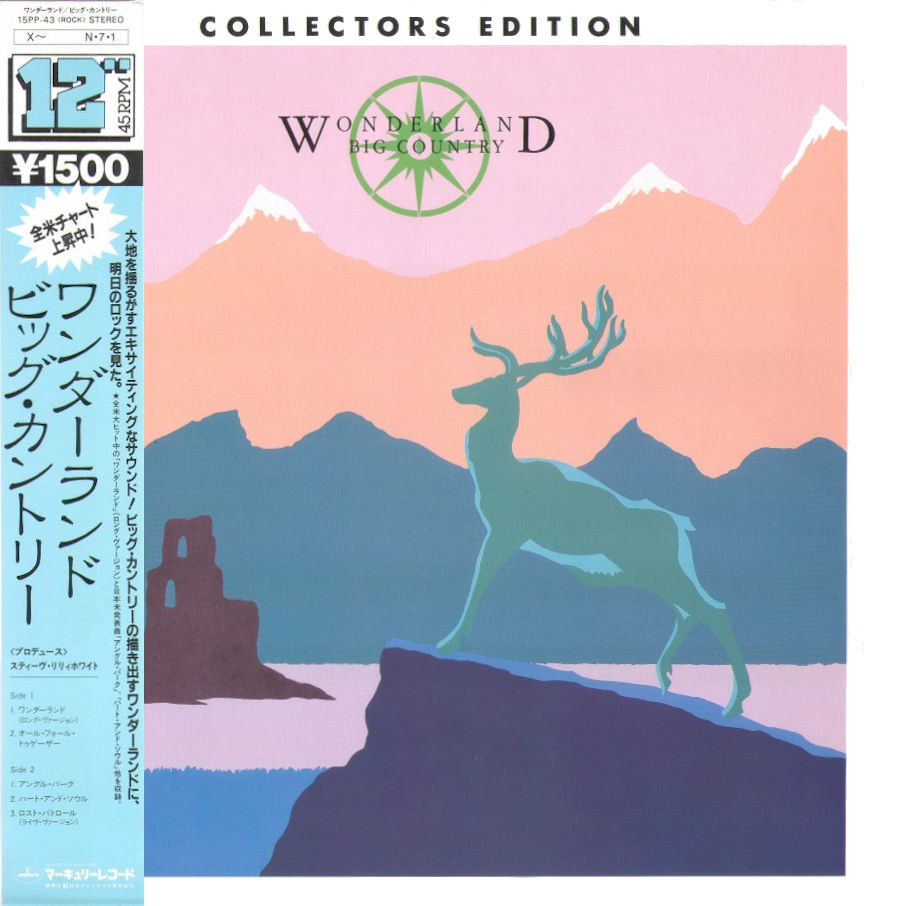
“Interestingly enough,” Balme continues, “we did some variance sleeves for a remix version of Wonderland. Basically, back in the day, you had four plates: cyan, magenta, yellow, and black. And I don’t know who it was, it might have been Andy [Murray, who had designed the green Crossing variant cover], but someone said, ‘how would it be if you printed the yellow plate cyan, and the magenta plate yellow?’ So basically, that’s actually what we came up with. Black was constant, but the other three you could shuffle around.”
The original Wonderland sleeve is rated among the band’s finest cover art, and many would love to see it adorn a standalone release again. If you base it on the longest existing Wonderland release, which is the Canadian six-track mini album, that by itself is 31 minutes 40 seconds long. If you go one step further, including all the other tracks included on the various Wonderland singles, EPs, and mini-albums, you get 12 tracks right there (including a few different versions of the same track). Adding the two work-in-progress versions of the main track, as well as Bruce’s demo, would give us a pretty comprehensive collection:
Wonderland [ultimate expanded deluxe “in our dreams” edition]: 1 - Wonderland 7’’ edit 2 - Wonderland (extended version) 12’’ edit 3 - Wonderland (original Bruce Watson demo) – from Bruce Watson’s “Last of the ‘Hole In the Head Gang’“ (2001), also reissued on Demology (2005) 4 - Wonderland (band demo #1) – officially released on the Steeltown deluxe edition as “Wonderland (Work In Progress Demo, take 1)". 5 - Wondergreat (band demo #2) – originally put on Bruce Watson's website in 2001. Included on the Steeltown deluxe edition as “Wonderland (Work In Progress Demo, take 2)". 6 - Giant (b-side to 7’’, common edit version) 7 - Giant (12’’ edit version) (12’’ single) 8 - All Fall Together (US 4-track EP, CA 6-track Mini-album) 9 - All Fall Together (Giant remix) (NL 12’’ EP) 10 - Angle Park (CA 6-track Mini-album) 11 - Heart and Soul (CA 6-track Mini-album) 12 - The Crossing (CA 6-track Mini-album) 13 - Chance (extended remix a.k.a. 12’’ version) (CA 6-track Mini-album) 14 - In A Big Country (12’’ version) (FR 12’’ single) 15 - Lost Patrol (live at Barrowlands). This track was spread across two 7’’ sides as part of a double 7’’ set as part 1 and part 2, as well as a complete song on the b-side on the American 7’’, the UK clear vinyl 12’’ EP, and the JP 12’’ EP.
The final word goes to Steve Lillywhite, who produced the original Wonderland single as well as the associated 12’’ mixes. He posted a video on his Instagram on 1 June 2019, after meeting some superfans in the Tokyo airport who asked him to sign a whole bunch of vinyl sleeves of albums that he had produced. This obviously included Big Country, but also U2, the Smiths, the Pogues, World Party, Peter Gabriel, Siouxie and the Banshees, the Rolling Stones, Johnny Thunders, etc.
Lillywhite wrote a very special message on the Wonderland 12 inch: ”This is my favourite 12” mix I ever did!” Given the incredible pedigree he has, the band’s many fans found it incredibly nice to know that Lillywhite’s work with Big Country is as special to him as it is to them.
Sources: - "A Certain Chemistry" by John May - Big Country Info @ www.bigcountryinfo.com by John Gouveia - "Stuart Adamson: In A Big Country" by Alan Glen - The Great Divide podcast @ www.bigcountrypodcast.com, hosted by Thomas Kercheval and Svein Børge Hjorthaug Special thanks to Andy Inkster for insights, videos, vintage magazine articles, and overall enthusiasm.

Facebook Comments